

Suunto Blog
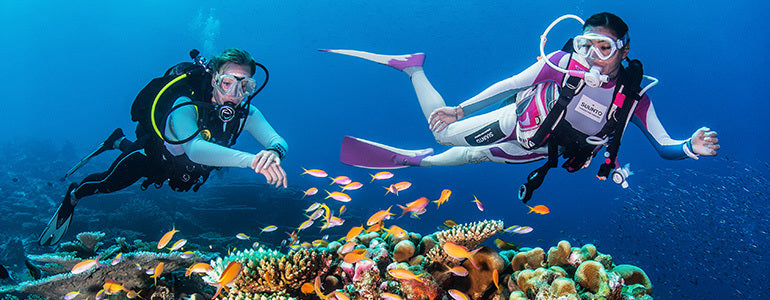
A pro diver’s essential tips for newbie divers
Teaching the joy of diving is Marco's passion. © atmosphereresorts.com
Diving isn’t an extreme sport
The classic newbie misunderstanding is thinking that diving is an extreme sport. Often they think it’s a very physical sport, but the opposite is true; diving is a very relaxed activity. Water is much denser than air, and that’s why we need to move slowly and be streamlined all the time. Once I taught a yoga teacher and after the dive she said, “being underwater is similar to a yoga class”.
Different strokes for different folks
Every person is different. One person, for example, needs much more time to get the buoyancy right, while another needs less (buoyancy is difficult in the beginning, but gets easier with practice). It’s important to be patient and to find an instructor you’re comfortable with so you can relax.
© Bo Mancao
Get in shape
You don’t need to train specifically to become a diver, but it’s helpful to be in good physical shape and a strong swimmer. Before you start your course, you need to sign a medical questionnaire to make sure you are fit to dive.
One step at a time
Don’t rush in and buy all the gear immediately. Give it time to make sure you really want to commit to diving. I highly recommend buying your own dive mask, however, because every face shape is different and it’s important to be comfortable. You can use it for snorkeling, too. If you decide diving is for you, then it makes sense to buy your personal dive gear. But go step by step.
© Bo Mancao
Follow the stars
Choosing the right dive center to learn at is important. It’s best to find a five star PADI center. Taking an online diving course is a great idea too so when you finish your studies online you can focus on the practical side of things.
Dive into open water
So, you’re 100% into diving! Time to complete an open water diving course! If you finish the theory online beforehand, an open water diving course can be completed in two to three days. With the theory included, it takes between three to four days. Don’t rush it. The instructor needs to make sure the students are ready. Following this is the advanced open water diver course.
Click to see the new Suunto Zoop Novo Blue*!
© Bo Mancao
Find a dive buddy
You should never dive alone. It’s safer and more fun to have a dive buddy, someone you trust, and whose equipment you’re familiar with. Diving is a very social activity so finding a buddy won’t be hard. You usually dive with someone you meet on a boat, at a resort, or in a dive shop. It’s important you speak about the dive and equipment before you take the plunge together.
Working with fear
Experiencing some level of fear is a very common experience for newbie divers. I was really afraid when I did my open water course. That’s when a good instructor can make all the difference. If the instructor is calm and gives the student time to adjust – because his or her brain is overloaded with new information – they usually work through it.
Marco won't be giving up his day job anytime soon. © atmosphereresorts.com
Keep diving!
Most people dive just for fun so they mainly dive when they’re on vacation. How often you dive depends on your personal goals, but diving once or twice every six months or year is a good idea so you avoid losing skills and familiarity.
*Suunto has just released the Zoop Novo Blue, a dive watch perfect for beginner divers or people seeking new adventures. Click here for more info about this simple to use dive computer.
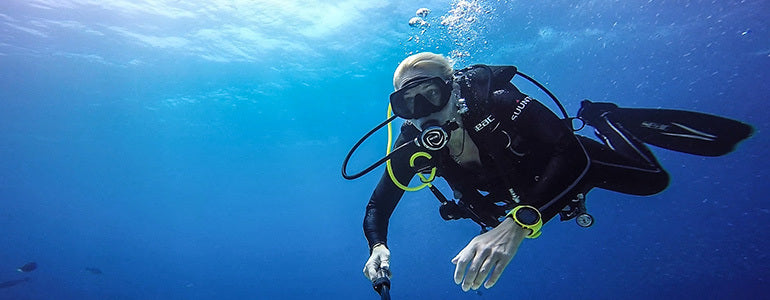
How to start diving
The famous Scuba Diving Girls Margo Sanchez and Stephanie Adamson are long-time champions of exploring the ocean. The Californians constantly share images and clips of themselves diving with playful seals, baby rays, turtles and sharks. Who better to ask how to start scuba diving?
© scubadivergirls.com
What do you say to someone thinking about diving for the first time?Just go for it. There is so much to see and experience with scuba diving. Don’t be afraid of all the gear, you will quickly get used to it and be empowered by it. There is really nothing that compares to this experience and you will not only love scuba diving, but also you will fall in love with a world unknown to you now.
“When you find a connection with the ocean and its inhabitants, it is a feeling you cannot ignore.”
What do you wish every newbie diver knew?
Have fun! Diving will bring so much joy to your life so remember to enjoy it. Make sure you find dive buddies who enjoy the experience and enhance your experience. It is important to follow your instincts and don’t let others intimidate you.
Click to see the new Suunto Zoop Novo Blue*!
© scubadivergirls.comWhat path do you recommend?Depending on your experience in the water, it may be good to try out scuba first. There is a class offered by most dive shops and independent instructors called Discover Scuba. This allows you to get in and get some instruction and try out the equipment before committing to a full certification class. But if you know you are ready, then it is time to sign up for an open water diving course.
“There’s nothing more memorizing than watching a shark glide by silently and unexpectedly or a seal who comes to pull on your fin as you frog kick your way through a kelp forest.”
What are the key steps to becoming a diver?
Finding a good instructor that you feel comfortable and safe with is the first step. Learn the skills and safety procedures during class and practice as often as possible. Even after you are certified, you should continue to practice the skills on a regular basis, as this will make you a better diver. Get as much time in the water as possible. Find buddies who are more advanced than you so that you can learn from their techniques. Don’t be lazy when it comes to your equipment care and maintenance. Your equipment is your lifeline.
© scubadivergirls.comWhat are the important things to remember? Safety should always be your first priority. It takes many dives before you are skilled enough to deal with the many issues you can experience under the surface. Understand your limits and never dive beyond these limits. If you want to do more advanced dives, take the classes to certify in that discipline first and even then be sure the diving is within your physical capabilities. When diving a new place find a local dive expert to guide you. Be sure you understand your gear. Diving should be super fun but always be sure safety is your primary focus.
*Suunto has just released the Zoop Novo Blue, a dive watch perfect for beginner divers or people seeking new adventures. Click here for more info about this simple to use dive computer.
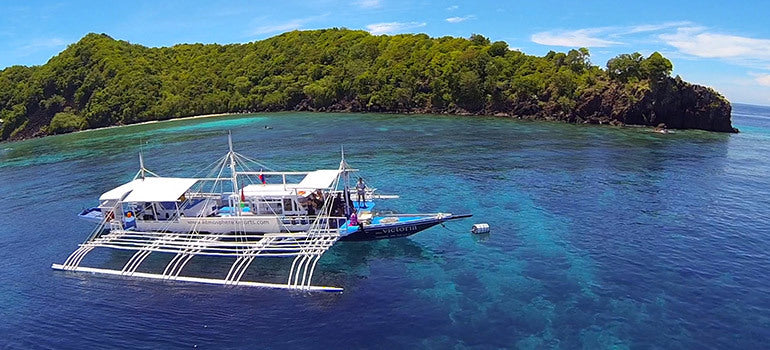
Win a diving trip to the Philippines and introduce your non-diving friend to the underwater world
As a diver you have probably seen some pretty amazing places. But have you been able to share your excitement with your non-diving friends? Explaining the experience certainly isn’t always easy. To overcome this you now have a chance to invite your friend, who is not yet familiar with diving, on a diving trip to the Philippines to explore the underwater world with you!
To get a chance to invite your friend on a diving trip post a picture of an unforgettable diving moment and tag your new-to-diving friend to the post. The winner of the contest will win a week-long trip for two to Atmosphere Resorts in the Philippines with flights included. The resort is beautifully situated on a beachfront location on the island of Negros Oriental near Dumaguete. Your friend will have a chance to participate on a four-day open water diving course at the resort.
Share a photo on Facebook or Instagram and tag it with your non-diving friend and #DiveWithMe and @suuntodive. The most inviting entry will be selected as the winner by Suunto and the Scuba Diver Girls. In addition to the main prize five Suunto Zoop Novo dive computers and PADI Open Water Touch e-learning packages will be raffled amongst all participants.
The contest period is March 17th – April 10th 2016.
See the full terms and conditions here
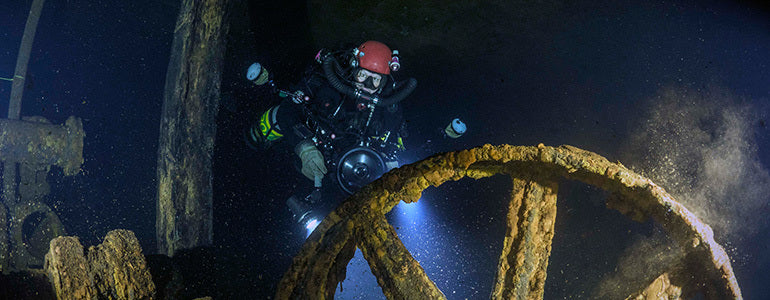
Diving in the abandoned Bell Island mine
It’s the Royal Canadian Geographical Society’s Expedition of the Year – the Bell Island Mine Dive. Suunto ambassador Jill Heinerth is part of the team exploring the vast and submerged mine system. Scroll down to learn more and to see images of this incredible dive site.
Canadian underwater explorer and technical diver Jill Heinerth is part of a team now exploring 100 km of long-abandoned mining passages beneath the seafloor of historic Bell Island, which lies off the coast of Newfoundland, Canada “The plan is to open this site for guided cave diving for experienced divers,” Jill says. “Ocean Quest Adventure Resort already boasts the ‘Truk of the North’ in terms of shipwrecks. Couple that with the mine, icebergs and humpback whales, and you have one of the finest diving destinations on the planet.”
“Shipwrecks, the mine, icebergs and humpback whales – one of the finest diving destinations on the planet.”
© Cas Dobbin 2016The plan for the expedition is to establish some primary guidelines for others to follow in the future and to get an idea of what was left in the mine when it was abandoned in 1966. So far, they have found everything from the remains of a miner’s lunch kit, an antique Pepsi Cola bottle, to large pumping equipment and pressure dampeners. “The walls of the mine also tell an important story; miners left behind basic graffiti on the walls such as columns of addition but also painted caricatures in lampblack and white crosses where their colleagues died. It all tells the anthropological story of mining.”
Click for more about Jill Heinerth
© Cas Dobbin 2016The expedition will also explore the island’s staunch local culture and WWII shipwrecks in its harbour. “The high-grade ore coming from the Bell Island mine was critical to shipbuilding during the war,” Jill says. “In 1942, a German U-Boat sunk four ore carriers and blew up the loading wharf on Bell Island. Seventy men died. The four shipwrecks are a part of this project and I will be back to document them in summer.” © Cas Dobbin 2016Engineers have helped the team assess and mitigate risks in the dry part of the mine. The hematite ore walls can collapse simply by leaning against them. Underwater, they have experienced whiteout conditions from inflowing meltwater. The remaining electrical supply line is an entanglement hazard. “We have to employ very prudent and conservative diving protocols to keep everyone safe and that means a big team topside to help in the logistics and safety.”
“It all tells the anthropological story of mining.”
The team includes some of the best technical divers in the world. Most are from Canada, and two others are from Britain and Germany. “The majority of the team is using rebreathers in order to lessen the impact of percolation from the ceiling and to increase warmth and comfort.”
Click for 7 off-season tips for divers
Fierce weather has created problems for the expedition. Blizzards, gales, floods and complete melts have each made things difficult. “The weather made travel across the Tickle to the island impossible on some days and on others we had a river of rushing meltwater flooding the infrastructure we had built for the project. It has not been easy, but we are learning about the forces of nature that will affect further exploration here.”
To follow news about the Bell Island Mine Dive expedition, click here.
Main image: © Cas Dobbin 2016
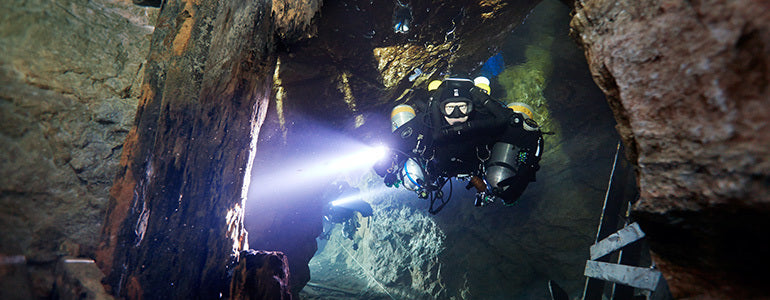
7 off-season tips for divers
Technical diver and commercial dive supervisor Andy Torbet began exploring the ocean when he was 12 and has been at it ever since. He’s explored sunken cities, elaborate cave systems, deep wrecks and reefs. We caught up with Andy just before he left for an expedition and asked what divers should do to stay dive-ready in the off-season. Here are his 7 off-season tips.
Don’t have an off-season
My personal recommendation for the off-season is not to have one. Even if you dive only very occasionally, and the dives are shallower and shorter than normal or even in a pool, it will help. They will keep those essential skills from fading and make sure your kit is working and familiar. Most diving incidents and accidents happen every year in spring when people come back to diving after taking the winter off. Just a quick dive a few times over the winter will help you stay on top of your game.
Andy explores Finland's Ojamo Mine, where Suunto tests its dive products. © Janne Suhonen “Most diving accidents happen in spring when people come back to diving after taking the winter off.”
Diving’s not physical, but it’s also physical
Diving is not primarily a physical performance sport but it is still physical. Recent medical investigations supported by incident reports have shown that your body is put under pressure even on simple dives and the more physically robust we can make ourselves the safer we are.
Why fitness matters
Ask yourself this: if two divers had identical diving skills, experience and attitude would you rather dive with the fit one or the out of shape one? Which diver do you think would have the greater chance of having a problem and which would you rather count on? Being physically fit can help in nearly all situations and is particularly important in some situations, from finning against a strong current, towing a casualty on the surface or just hauling oneself out of the water in a less than ideal condition. “Being physically fit can help in nearly all situations.”
© Martin Hartley
Take care of your body
It’s worth keeping a basic level of activity going in the off-season to keep you healthy for the new season. I know a lot of divers who go hill walking in winter just to keep their bodies active. But it’s also a time to look at doing some work on those problem areas you’ve been putting off (because you were too busy diving). Perhaps it’s a sore shoulder or a weak knee. Make sure you start the new season in the best shape possible. That way you can dive more, enjoy it more and be capable of more.
Core strength is key
Diving kit is heavy so spend some time working on your strength, and especially core strength. I’ve seen a number of dives cut short because someone injured their lower back getting kitted up. You can spend the spare time in the off-season getting into the habit so when you start diving again these exercises have become part of your routine.“I’ve seen a number of dives cut short because someone injured their lower back getting kitted up.”© Janne Suhonen
Maintain and take stock
I don’t have an off-season, but the winter is less busy so I use that period to service equipment, look at what needs replacing or go over the last year and see what I could can change or improve for next year. It’s an opportunity to take stock and look to improve.
Stay inspired
Keep yourself inspired. The off-season is also a good time to start planning projects or booking those courses you want to get done. Get the paperwork side of things done when the weather is bad to make full use of your time when it’s time to start diving.
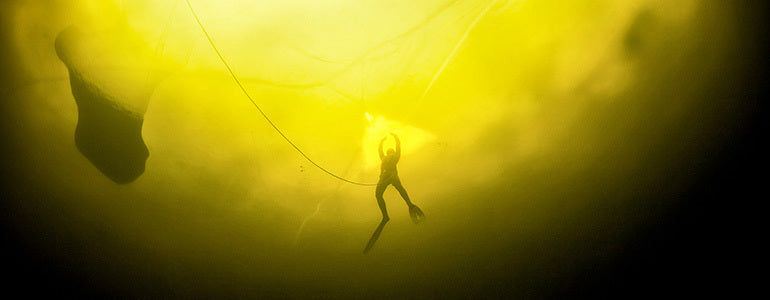
Four reasons to try ice diving
Usually freediving events are held in warm and sunny locations like Dean’s Blue Hole in the Bahamas, but not Asikkala on the Rocks. It’s held every March in Finland and involves plunging through a hole in a sheet of ice and diving down into the biting waters beneath. Pure madness, you think? “Not at all,” says organizer Antero Joki, Finland’s top freediver. “It’s a spiritual feeling. It’s not about how deep you go, it’s about the feeling.” Here’re four reasons to give ice freediving a go.
Feeling brave? Jump in in your swimsuit. © Pekka TuuriThe thrill of the cold Despite what you might think, diving in frigid water doesn’t feel terrible once you get past the initial shock. “It’s actually thrilling,” Antero says. “Every time someone overcomes their fear of the cold and goes for it, they come out of the water smiling. Of course you can feel the coldness through your wetsuit, but it’s not bad. You can stay in only for half an hour, but that’s enough to enjoy this incredible underwater experience.”
“Every time someone overcomes their fear of the cold and goes for it, they come out of the water smiling.”
© Pekka Tuuri
The underwater ambience
“It’s hard to describe this; you have to experience it for yourself,” Antero says. “There’s total silence. There’s this twilight light and the ice creates a shadow theater. You can see shadows of the people moving on the surface of the ice. And even though it’s cold, it feels cozy.” It teaches relaxation “It’s always a maximum of 4°C below 10 m so it’s always cold and it’s always dark,” Antero says. “But when you learn to relax in a cold and dark water it means when you freedive in warm water it’s so much easier to be relaxed.”
© Pekka TuuriThe Finnish saunas Before plunging through the ice, Asikkala on the Rocks participants relax in saunas to prepare themselves and then again afterwards to warm up. “The combination of warmth and cold is good for body and mind,” Antero says. “It’s a very relaxing atmosphere.”
MAIN IMAGE: © Pekka Tuuri














































































